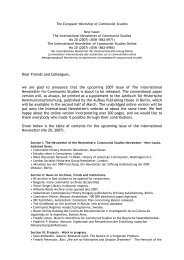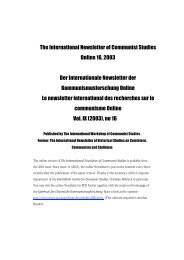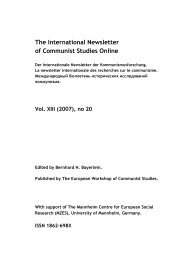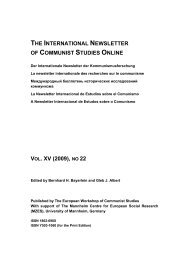VOL. XVI (2010), NO 23 - The International Newsletter of Communist ...
VOL. XVI (2010), NO 23 - The International Newsletter of Communist ...
VOL. XVI (2010), NO 23 - The International Newsletter of Communist ...
Erfolgreiche ePaper selbst erstellen
Machen Sie aus Ihren PDF Publikationen ein blätterbares Flipbook mit unserer einzigartigen Google optimierten e-Paper Software.
<strong>The</strong> <strong>International</strong> <strong>Newsletter</strong> <strong>of</strong> <strong>Communist</strong> Studies Online <strong>XVI</strong> (<strong>2010</strong>), no. <strong>23</strong> 159<br />
Grigorij Grigorov: Povoroty sud'by i proizvol. Vospominanija. 1905-1927 gody,<br />
Moskva, OGI, 2005. 536 p. (Častnyj archiv). ISBN 5-94282-281-6; Grigorij<br />
Grigorov: Povoroty sud’by i proizvol. Vospominanija. 1928-1972, [Akko, Israel],<br />
s.p., [2008]. 682 p. No ISBN.<br />
Not many members <strong>of</strong> the Left Opposition in the Soviet Union survived Stalin's terror regime.<br />
Those who wrote about their experiences <strong>of</strong> struggle and repression constitute even a lesser<br />
quantity. In 2005, the OGI publishing house released such a rare document – the first<br />
volume <strong>of</strong> the memoirs <strong>of</strong> Grigorii Isaevich Grigorov (1900-1994), revolutionary, scientist,<br />
dissident and GuLAG inmate. Born into a Jewish craftsman family, Grigorov joins the<br />
revolutionary movement as a teenager, takes part in the revolutions <strong>of</strong> February and October<br />
1917, fights on the side <strong>of</strong> the Reds in the Civil War, becomes imprisoned by Denikin and is<br />
freed again by Nestor Makhno. After the war, Grigorov succeeds in obtaining a proper<br />
education through rabfak institutions, specialises himself in philosophy and becomes a "red<br />
pr<strong>of</strong>essor", obtaining a doctoral degree with a monograph on Spinoza and being close to<br />
Abram Deborin, Evgenii Preobrazhenskii and David Riazanov. Having an independent<br />
mindset and not being content with the bureaucratisation <strong>of</strong> the party, Grigorov associates<br />
himself with the Opposition from 19<strong>23</strong> on, and is forced to move to Siberia, where he can<br />
work relatively freely due to his friendship with Vladimir Kosior. From 1926 on, when the<br />
struggle between the United (<strong>Communist</strong>) Opposition and Stalin's circle reaches a new level,<br />
Grigorov takes part in the work <strong>of</strong> clandestine circles, crossing paths with Lev Trotskii, Karl<br />
Radek, Victor Serge and other prominent oppositionists. <strong>The</strong> first volume ends with the<br />
author's expulsion from the party in 1927.<br />
A planned 2nd volume did not see the light in Russia for unknown reasons. Instead,<br />
Grigorov's son, who lives in Israel, has put out a very limited print run <strong>of</strong> the 2nd volume in<br />
2008. Dealing with the period between 1928 and 1972, it proves to be a fascinating and<br />
highly valuable source on the Stalin era. In 1928, after the “capitulation” <strong>of</strong> Radek,<br />
Preobrazhenskii and Smilga, Grigorov is more than ever active for the Opposition - yet in a<br />
way that fails to please him: Carrying out the controversial tactical decision <strong>of</strong> the Left<br />
Opposition’s leadership to disbandon oppositionist groups in order to be able to operate<br />
within the party, he goes on a liquidatory mission into the Soviet province, including the<br />
Caucasus, and is confronted with frustration <strong>of</strong> rank-and-file oppositionists who are not at all<br />
willing to give up the organised struggle. In the same year, Grigorov faces arrest and<br />
deportation to a village in the Ural, where he spends the next two years together with Decist<br />
leader Vladimir Smirnov, first-hand experiencing the brutal peasant collectivisation. After a<br />
brief period <strong>of</strong> freedom back in Leningrad, Grigorov and his wife (an old Bolshevik<br />
revolutionary herself) get arrested straight after the Kirov murder in 1934. What follows is an<br />
odyssey through several GULag camps, where the couple manages to stay together for<br />
most <strong>of</strong> the time. Grigorov experiences the Trotsyist prisoners' famous hunger strike in<br />
Vorkuta (in which he does not take part) and the massacre that followed thereafter – and it is<br />
striking that the information on these events, which he brought to paper in the 1970s-1980s<br />
without access to any sources, corresponds with the findings <strong>of</strong> recent research. 1 After being<br />
released in 1939, again his freedom does not last long: he is mobilized into the army for the<br />
war against Finland, captured by enemy troops and spends the following (comparably easy)<br />
years as a POW in Finland. In 1944, after the Soviet Union made peace with Finland,<br />
Grigorov is arrested again by the infamous SMERSh counter-intelligence, and another<br />
1 Comp.: Jean-Jacques Marie: Der Widerstand der Trotzkisten im Gulag 1936 bis 1938. Der Hungerstreik und das<br />
Massaker in Vorkuta. In: Jahrbuch für Historische Kommunismusforschung (2007), pp. 117-136; Id.: Les trotskystes<br />
à Vorkouta. In: Cahier du mouvement ouvrier (2007), N° 34.














